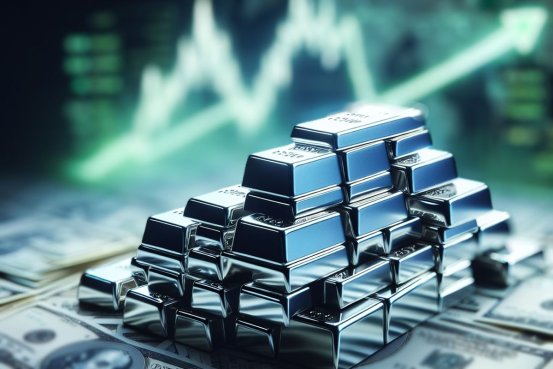

Artificial intelligence is fueling a powerful new wave of silver demand. The rise of electric vehicles and next-generation batteries is amplifying it even further. In short, silver has always played a vital role in the green economy — but today, a unique mix of global forces is transforming the market’s foundation. This article provides a clear, fact-driven overview of how individuals can realistically engage with this accelerating trend.
Artificial intelligence is fueling a powerful new wave of silver demand. The rise of electric vehicles and next-generation batteries is amplifying it even further. In short, silver has always played a vital role in the green economy — but today, a unique mix of global forces is transforming the market’s foundation. This article provides a clear, fact-driven overview of how individuals can realistically engage with this accelerating trend.

Silver holds a distinctive place in the world economy, serving both as an essential industrial material and a traditional store of wealth. Unlike gold, which is mainly valued for jewellery and investment, silver’s industrial uses link it directly to innovation cycles and manufacturing growth. Recent fluctuations in silver prices have reignited attention among investors seeking diversification and exposure to precious metals. Gaining a solid understanding of silver’s underlying fundamentals allows investors to decide whether this metal deserves inclusion in their investment strategies.
Silver’s unparalleled electrical and thermal conductivity, reflectivity, and antibacterial properties make it a cornerstone material across many sectors. It is especially critical in solar panel production, where photovoltaic cells rely on silver paste for efficient electrical flow. As renewable energy expansion continues globally, demand from solar manufacturers is steadily increasing. Silver also plays a central role in electronics, appearing in smartphones, circuit boards, and automotive systems. Electric vehicles, in particular, contain far more silver than combustion engine models due to their higher electronic content and complex battery systems. In the medical field, silver’s antimicrobial qualities are applied to wound care, surgical tools, and surface coatings. These diverse uses give silver a strong industrial foundation that helps support prices. However, if costs rise too high, industries may look for substitutes — a reminder that silver’s market is shaped by constant innovation and balance between price and utility.
There are several methods investors can use to gain exposure to silver, each with unique advantages and risks. Buying physical silver — coins, bars, or bullion — provides direct ownership, though it also requires storage security and insurance. Premiums above spot price differ depending on size and dealer, with smaller units often costing more per ounce. Exchange-traded funds (ETFs) offer convenient exposure to silver’s market performance without the need to handle physical metal. Shares of silver mining companies provide leveraged exposure, as profits tend to move more sharply with metal prices, but they also carry operational and regional risks. Futures and options allow experienced investors to trade silver using leverage, though these require deep understanding of market mechanisms and margin requirements. Finally, pooled or allocated storage accounts offer partial ownership of physical silver under professional custody, appealing to investors who prefer indirect physical exposure without logistical burdens.
Silver is known for its high volatility compared to gold, bringing both strong potential returns and greater risk. Historical trends show silver often outperforms gold during bull markets but also suffers steeper declines in downturns. Over the long term, silver has maintained purchasing power but has rarely surpassed diversified stock portfolios. Investors should view silver as a cyclical asset influenced by industrial activity, inflation expectations, and investor sentiment. The gold-to-silver ratio — which shows how many ounces of silver equal one ounce of gold — has historically ranged between 40:1 and 100:1, offering perspective on market valuation. As a rule, silver works best as a portfolio hedge or inflation guard, not as a primary growth driver. Most financial advisors recommend limiting total precious metal exposure to around 5–10% of one’s assets. Short-term trading in silver demands technical analysis and strong risk control since price swings can be rapid and significant.
Investing in silver involves several notable risks. Its price volatility is higher than that of most commodities, with large percentage changes occurring in short timeframes. Because much of its demand is industrial, global economic downturns can reduce consumption and pressure prices. Storage fees and insurance costs can diminish returns for physical holdings, while ETF investors face management fees. Counterparty and solvency risks may arise with pooled accounts or certain financial instruments. Regulatory shifts affecting mining or trade policies can alter supply and demand patterns. Currency movements also affect silver’s value since it is primarily traded in US dollars. Liquidity varies depending on investment type, and selling physical silver quickly at fair value can sometimes be difficult. Managing these risks involves diversification across silver products, limiting position sizes, and using trusted dealers or custodians. Investors should also understand taxation rules for different investment types and periodically rebalance portfolios to prevent overexposure during market rallies.
Silver provides both diversification benefits and exposure to vital global trends such as renewable energy and electrification. Yet, successful investing in silver requires patience, realistic expectations, and disciplined management. Its dual role — part industrial metal, part monetary asset — creates market dynamics unlike any other commodity. While technological growth supports long-term demand, short-term prices are still influenced by speculation and macroeconomic sentiment. Anyone considering silver should research carefully, choose appropriate investment vehicles, and maintain a balanced perspective on its place within an overall strategy. The key is to allocate responsibly, avoid overleveraging, and treat silver as one piece of a broader, diversified portfolio. Whether the “silver boom” continues depends on economic growth, policy shifts, and innovation — factors that no one can fully predict. Investors who understand silver’s nature and align it with their risk tolerance are best positioned to benefit from its unique potential over the long run.